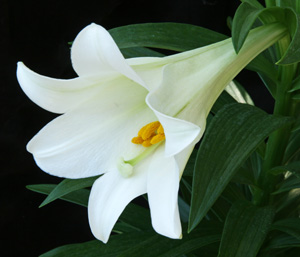House and Garden Plants Potentially Poisonous to Pets
By Ann M. Mason, Fairfax Master Gardener Intern

Easter Lily
As a dog lover, I am struck with my dog’s concentrated determination and focus for eating grass after bounding joyously out of the house for a walk or for a potty break. Having ingested grass, my dog returns to the house and immediately throws up on the same carpeted place just inside our front door. This raises the question, “Is grass toxic to my dog?” I am not alone in asking this question. While staffing our Master Gardener table at plant clinics. we’ve been asked the question, “What garden plants are toxic to pets?”
Now that the weather is cooler, gardeners are putting their gardens to bed, planning for spring plantings and adding seasonal plants and flowers to their homes. So, beyond the question of toxic plants in the garden, in this article we explore the broader question, “What indoor and outdoor plants are potentially poisonous to dogs and cats?”

Naked Lady
Animal scientists at the American Society for the Prevention of Cruelty to Animals (ASPCA) report that “consumption of any plant material may cause vomiting and gastrointestinal upset for dogs and cats.” From toxicology we know that both the amount (the dose) and the severity of the toxicant play an important role in the severity of any poisoning event. Plants are not equally toxic; nor do all plant parts pose the same level of concern. To differentiate the differences in toxicity, experts established a numeric 4-scale system: They assigned a score of 1 to a plant with major toxicity — the potential to cause serious illness or death if ingested; 2 for plants with minor toxicity where ingestion may cause vomiting or diarrhea when ingested; 3 for plants where the juice or sap contain needle-shaped oxalate crystals that can irritate skin, mouth, tongue and throat that can result in throat swelling, breathing difficulties, burning pain and stomach upset; and 4 for plants where contact can cause skin rash, irritation. Some plants have a score of 1 or 2 and 4, meaning that they could pose both and ingestion and skin sensitization hazard.
After my research I was relieved that the experts do not list grasses typically used for turf with a potential for poisoning dogs. Dogs are omnivores and sometimes ‘crave’ plants. Vomiting is a common reaction to grazing. Most veterinary sites I researched are not alarmed. However, if the turf had a recent application of lawn chemicals or herbicides and the dog reacts abnormally, the sites encourage the owner to call their veterinarian.
While the answer about grass was a relief, my alarm elevated when experts identified hundreds of my ‘favorite’ plants as ones that can potentially poison cats and dogs. Like many, my garden includes daffodils (Narcissus sp), azaleas (Rhododendron sp), peonies (Paeonia sp), and lilies, especially Tiger Lily (Lilium lancifolium). In addition, when my glen of mayapples (Podophyllum peltatum) emerges, I know spring is finally here.

Mistletoe
Now that the weather is becoming chilly and the hours of daylight shorten, many of us turn our sights toward decorating our homes with seasonal plants for the winter holidays. No doubt we have all heard the warning to keep pets away from poinsettia (Euphorbia pulcherrima). But I was surprised to learn that the university and veterinary experts dismissed that concern as overblown.
Instead, the collective highest concern was for all forms of lilies (Lilium spp and Hemerocallis sp)! After ingesting any part of the lily — flowers, petals, leaves, stems and bulbs — a dog or cat can suffer severe reactions. Cats are so sensitive that ingesting any part of the lily plant can cause complete kidney failure within a short time.
As we pet lovers or owners select plants for our homes and gardens, it seems prudent to add other factor to our process, that is, the behavior of our pet with plants. For example, choices in plants might be influenced if your pet digs and eats bulbs and roots, especially when unsupervised, or If the pet likes to mouth/eat the foliage of our house plants or cut flowers.
While my research uncovered over 1,000 potentially poisonous plants, this article provides two ‘short’ lists of plants selected based on information from university scientists and veterinary clinics. These lists include plants these experts reported as the ones that most frequently triggered visits or calls to animal poison control centers. In general, these lists apply to both cats and dogs. Table 1 identifies house and seasonal plants; Table 2 lists some garden, ornamental, woodland and one vegetable plant. Interested readers can use the resources provides to link to websites with additional (actually hundreds of) plant names.
If you think that your pets might be ill from ingesting a poisonous plant part, gardeners should check with their veterinarian or call the 24-hour ASPCA animal poison control center number [1-888-426-4435] for further information. American Society for the Prevention of Cruelty to Animals (ASPCA) website provides an extensive set of lists identifying both toxic and non-toxic plants to dogs, cats and horses on its website.
Resources
• Toxic and Non-Toxic Plants List, American Society for the Prevention of Cruelty to Animals
• Plants That May Poison Your Pets, Humane Society of the United States,
• Top 10 Plants Poisonous to Pets, State College Veterinary Hospital, State College, PA
• Dog Health, Beware: Pets and Toxic Plants, University of California Davis School of
Veterinary Medicine,
• Plants Poisonous to Livestock and Other Animals, Cornell University,
• Plants Toxic to Animals University of Illinois Library
• Important Tips from Penn Vet to Keep Pets Safe During the Holidays, University of Pennsylvania
School of Veterinary Medicine,
• Lovely Lilies and Curious Cats: A Dangerous Combination, US Food and Drug Administration
… updated 2023

